fuel pressure OPEL MOVANO_B 2017 Manual user
[x] Cancel search | Manufacturer: OPEL, Model Year: 2017, Model line: MOVANO_B, Model: OPEL MOVANO_B 2017Pages: 255, PDF Size: 6.12 MB
Page 80 of 255
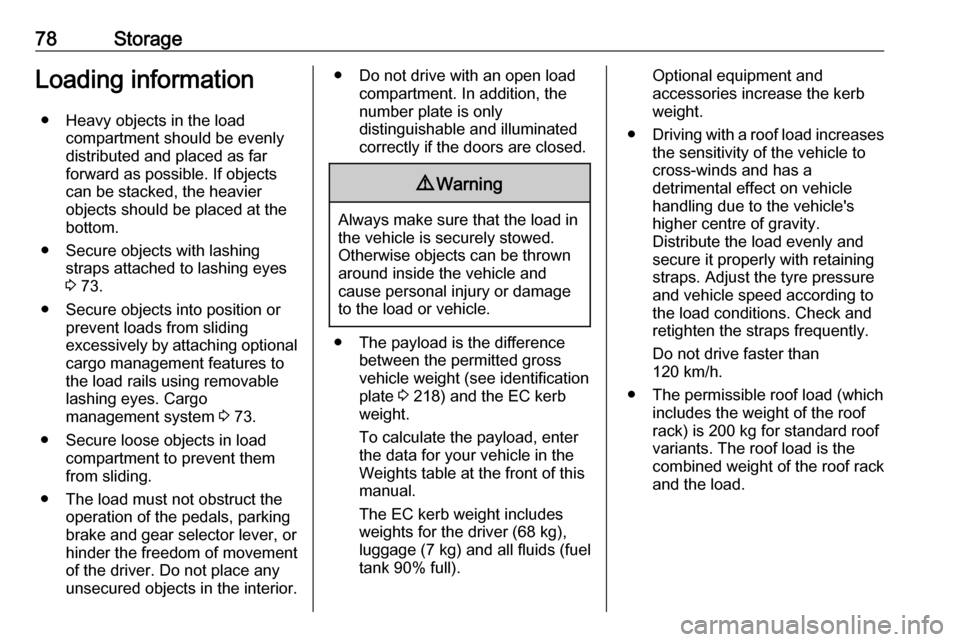
78StorageLoading information● Heavy objects in the load compartment should be evenlydistributed and placed as far
forward as possible. If objects
can be stacked, the heavier
objects should be placed at the
bottom.
● Secure objects with lashing straps attached to lashing eyes
3 73.
● Secure objects into position or prevent loads from sliding
excessively by attaching optional
cargo management features to
the load rails using removable
lashing eyes. Cargo
management system 3 73.
● Secure loose objects in load compartment to prevent themfrom sliding.
● The load must not obstruct the operation of the pedals, parking
brake and gear selector lever, or
hinder the freedom of movement of the driver. Do not place any
unsecured objects in the interior.● Do not drive with an open load compartment. In addition, the
number plate is only
distinguishable and illuminated correctly if the doors are closed.9 Warning
Always make sure that the load in
the vehicle is securely stowed.
Otherwise objects can be thrown
around inside the vehicle and
cause personal injury or damage
to the load or vehicle.
● The payload is the difference between the permitted gross
vehicle weight (see identification
plate 3 218) and the EC kerb
weight.
To calculate the payload, enter
the data for your vehicle in the
Weights table at the front of this
manual.
The EC kerb weight includes
weights for the driver (68 kg),
luggage (7 kg) and all fluids (fuel
tank 90% full).
Optional equipment and
accessories increase the kerb
weight.
● Driving with a roof load increases
the sensitivity of the vehicle to
cross-winds and has a
detrimental effect on vehicle
handling due to the vehicle's
higher centre of gravity.
Distribute the load evenly and secure it properly with retaining
straps. Adjust the tyre pressure
and vehicle speed according to
the load conditions. Check and
retighten the straps frequently.
Do not drive faster than
120 km/h.
● The permissible roof load (which includes the weight of the roof
rack) is 200 kg for standard roof
variants. The roof load is the combined weight of the roof rack
and the load.
Page 81 of 255

Instruments and controls79Instruments and
controlsControls ....................................... 80
Steering wheel adjustment ........80
Steering wheel controls .............80
Horn ........................................... 80
Steering column controls ...........80
Windscreen wiper/washer .........81
Outside temperature ..................82
Clock ......................................... 83
Power outlets ............................. 83
Cigarette lighter ......................... 84
Ashtrays .................................... 84
Warning lights, gauges and indi‐
cators ........................................... 85
Instrument cluster ......................85
Speedometer ............................. 85
Odometer .................................. 86
Trip odometer ............................ 86
Tachometer ............................... 86
Fuel gauge ................................ 86
AdBlue gauge ............................ 87
Engine coolant temperature gauge ....................................... 87
Engine oil level monitor .............87
Service display .......................... 88Transmission display .................88
Control indicators ......................89
Turn signal ................................. 92
Seat belt reminder .....................92
Airbag and belt tensioners .........92
Airbag deactivation ....................92
Charging system .......................93
Malfunction indicator light ..........93
Service vehicle soon .................93
Stop engine ............................... 94
Brake system ............................. 94
Antilock brake system (ABS) .....94
Upshift ....................................... 94
Lane departure warning ............94
Electronic Stability Program ......95
Electronic Stability Program off ............................................. 95
Engine coolant temperature ......95
Preheating ................................. 95
AdBlue ....................................... 95
Tyre pressure monitoring system ...................................... 95
Engine oil pressure ....................96
Low fuel ..................................... 96
Stop-start system ......................96
Exterior light .............................. 97
High beam ................................. 97
High beam assist .......................97
Fog light ..................................... 97
Rear fog light ............................. 97Cruise control............................ 97
Tachograph ............................... 97
Door open .................................. 97
Information displays .....................98
Driver Information Centre ..........98
Info display ................................ 98
Vehicle messages ........................99
Warning chimes .........................99
Trip computer ............................. 100
Tachograph ................................ 102
Page 93 of 255
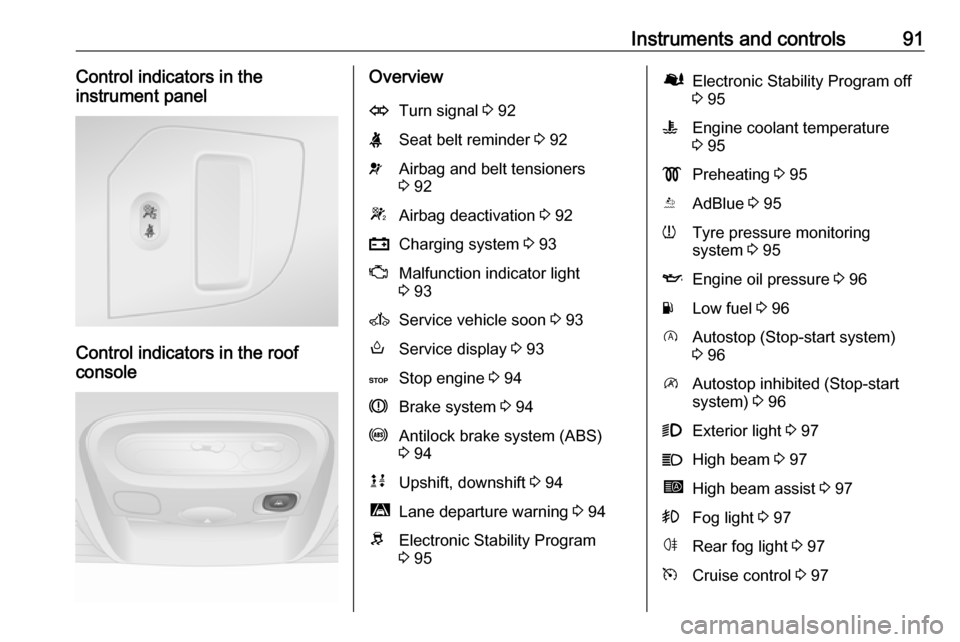
Instruments and controls91Control indicators in the
instrument panel
Control indicators in the roof
console
OverviewOTurn signal 3 92XSeat belt reminder 3 92vAirbag and belt tensioners
3 92WAirbag deactivation 3 92pCharging system 3 93ZMalfunction indicator light
3 93AService vehicle soon 3 93oService display 3 93CStop engine 3 94RBrake system 3 94uAntilock brake system (ABS)
3 94kjUpshift, downshift 3 94ìLane departure warning 3 94RElectronic Stability Program
3 95ØElectronic Stability Program off
3 95WEngine coolant temperature
3 95!Preheating 3 95YAdBlue 3 95wTyre pressure monitoring
system 3 95IEngine oil pressure 3 96YLow fuel 3 96DAutostop (Stop-start system)
3 96\Autostop inhibited (Stop-start
system) 3 969Exterior light 3 97CHigh beam 3 97íHigh beam assist 3 97>Fog light 3 97øRear fog light 3 97mCruise control 3 97
Page 98 of 255
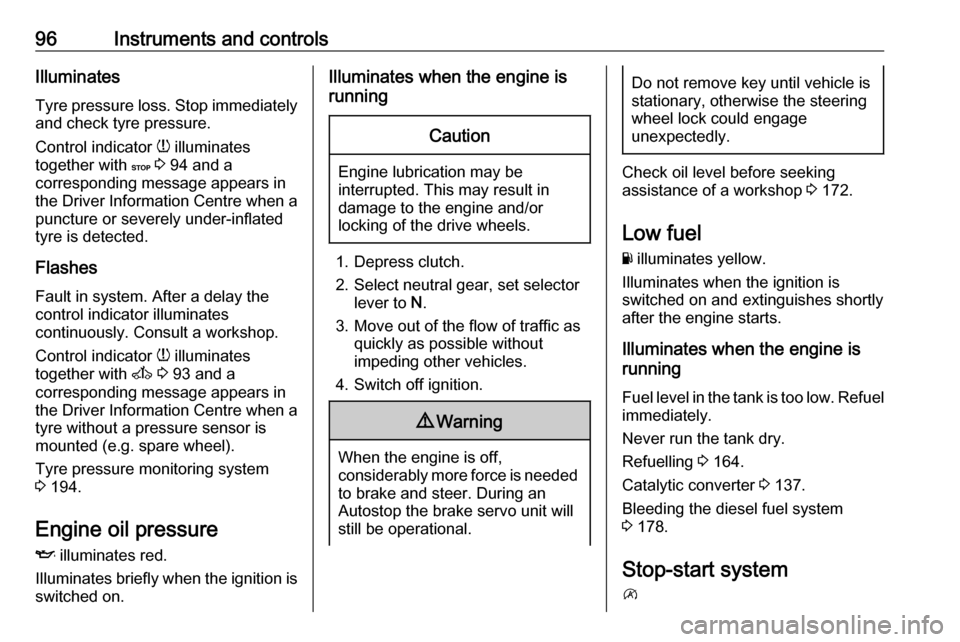
96Instruments and controlsIlluminates
Tyre pressure loss. Stop immediately
and check tyre pressure.
Control indicator w illuminates
together with C 3 94 and a
corresponding message appears in
the Driver Information Centre when a puncture or severely under-inflated
tyre is detected.
Flashes
Fault in system. After a delay the
control indicator illuminates
continuously. Consult a workshop.
Control indicator w illuminates
together with A 3 93 and a
corresponding message appears in
the Driver Information Centre when a
tyre without a pressure sensor is
mounted (e.g. spare wheel).
Tyre pressure monitoring system
3 194.
Engine oil pressure
I illuminates red.
Illuminates briefly when the ignition is
switched on.Illuminates when the engine is
runningCaution
Engine lubrication may be
interrupted. This may result in
damage to the engine and/or
locking of the drive wheels.
1. Depress clutch.
2. Select neutral gear, set selector lever to N.
3. Move out of the flow of traffic as quickly as possible without
impeding other vehicles.
4. Switch off ignition.
9 Warning
When the engine is off,
considerably more force is needed
to brake and steer. During an
Autostop the brake servo unit will still be operational.
Do not remove key until vehicle is
stationary, otherwise the steeringwheel lock could engage
unexpectedly.
Check oil level before seeking
assistance of a workshop 3 172.
Low fuel
Y illuminates yellow.
Illuminates when the ignition is
switched on and extinguishes shortly
after the engine starts.
Illuminates when the engine is
running
Fuel level in the tank is too low. Refuel
immediately.
Never run the tank dry.
Refuelling 3 164.
Catalytic converter 3 137.
Bleeding the diesel fuel system
3 178.
Stop-start system
\
Page 101 of 255

Instruments and controls99Vehicle messages
Messages appear in the Driver
Information Centre, in combination
with control indicator A or C.
Information messagesInformation messagesBATTERY MODE: ECONOMYESP OFFAUTO LIGHTS DEACTIVATEDOIL LEVEL CORRECT
Fault messages Displayed in combination with control
indicator A. Drive with caution and
seek the assistance of a workshop.
To remove fault message, press
button on end of wiper lever. After a
few seconds the message may
disappear automatically and A
remains illuminated. The fault will
then be stored in the on board
system.
Fault messagesCHECK ESPCHECK FUEL FILTERCHECK GEARBOXCHECK AUTO LIGHTS
Warning messages
These may appear with control
indicator C or in combination with
other warning messages, control
indicators or an audible warning. Stop engine immediately and seek the
assistance of a workshop.
Warning messagesINJECTION FAULTENGINE OVERHEATINGGEARBOX OVERHEATING
Tyre pressure monitoring system
3 194.
Warning chimes
When starting the engine or whilst
driving
Only one warning chime will sound at a time.
The warning chime regarding
unfastened seat belts has priority
over any other warning chime.
● If seat belt is not fastened 3 52.
● If a certain speed is exceeded with the parking brake applied
3 150.
● If the parking assist detects an object or a fault is present
3 158.
● If the vehicle has manual transmission automated and the
clutch temperature is too high
3 145.
● If the vehicle speed briefly exceeds a set limit 3 85.
● During closing of the power sliding door 3 27.
● If the sliding door is open and the
parking brake is released 3 27.
Page 131 of 255
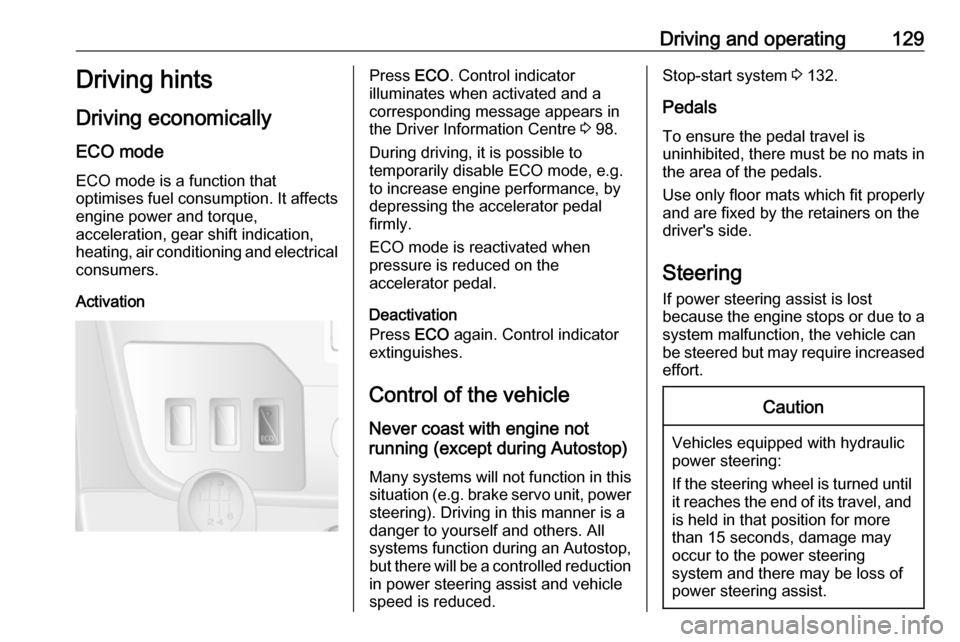
Driving and operating129Driving hints
Driving economically
ECO mode ECO mode is a function that
optimises fuel consumption. It affects
engine power and torque,
acceleration, gear shift indication,
heating, air conditioning and electrical consumers.
ActivationPress ECO. Control indicator
illuminates when activated and a corresponding message appears in
the Driver Information Centre 3 98.
During driving, it is possible to
temporarily disable ECO mode, e.g.
to increase engine performance, by
depressing the accelerator pedal
firmly.
ECO mode is reactivated when
pressure is reduced on the
accelerator pedal.
Deactivation
Press ECO again. Control indicator
extinguishes.
Control of the vehicle
Never coast with engine not
running (except during Autostop)
Many systems will not function in this
situation (e.g. brake servo unit, power
steering). Driving in this manner is a
danger to yourself and others. All
systems function during an Autostop,
but there will be a controlled reduction
in power steering assist and vehicle
speed is reduced.Stop-start system 3 132.
Pedals To ensure the pedal travel is
uninhibited, there must be no mats in
the area of the pedals.
Use only floor mats which fit properly
and are fixed by the retainers on the
driver's side.
Steering
If power steering assist is lost
because the engine stops or due to a system malfunction, the vehicle can
be steered but may require increased
effort.Caution
Vehicles equipped with hydraulic
power steering:
If the steering wheel is turned until it reaches the end of its travel, and
is held in that position for more
than 15 seconds, damage may
occur to the power steering
system and there may be loss of
power steering assist.
Page 171 of 255

Vehicle care169Vehicle careGeneral Information...................170
Accessories and vehicle modifications .......................... 170
Vehicle storage ........................170
End-of-life vehicle recovery .....171
Vehicle checks ........................... 171
Performing work ......................171
Bonnet ..................................... 171
Engine oil ................................. 172
Engine coolant ......................... 173
Power steering fluid .................174
Washer fluid ............................ 175
Brakes ..................................... 175
Brake fluid ............................... 175
Vehicle battery ......................... 175
Diesel fuel filter ........................178
Diesel fuel system bleeding .....178
Wiper blade replacement ........179
Bulb replacement .......................179
Headlights ............................... 179
Adaptive forward lighting .........182
Fog lights ................................. 182
Front turn signal lights .............182
Tail lights ................................. 183
Side turn signal lights ..............184Centre high-mounted brake
light ......................................... 185
Number plate light ...................185
Interior lights ............................ 186
Instrument panel illumination ...187
Electrical system ........................187
Fuses ....................................... 187
Engine compartment fuse box . 188
Instrument panel fuse box .......189
Load compartment fuse box ....190
Vehicle tools .............................. 192
Tools ........................................ 192
Wheels and tyres .......................193
Tyres ....................................... 193
Winter tyres ............................. 193
Tyre designations ....................193
Tyre pressure .......................... 193
Tyre pressure monitoring system .................................... 194
Tread depth ............................. 196
Changing tyre and wheel size . 197 Wheel covers ........................... 197
Tyre chains .............................. 197
Tyre repair kit .......................... 198
Wheel changing .......................201
Spare wheel ............................ 203
Jump starting ............................. 206Towing....................................... 208
Towing the vehicle ...................208
Towing another vehicle ...........209
Appearance care .......................209
Exterior care ............................ 209
Interior care ............................. 211
Page 172 of 255
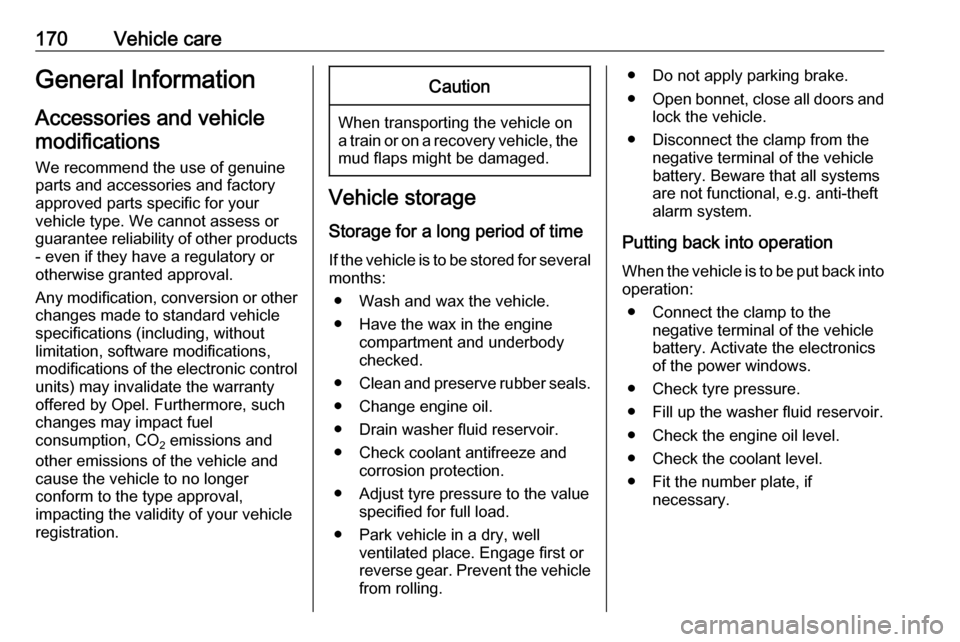
170Vehicle careGeneral Information
Accessories and vehicle modifications
We recommend the use of genuine
parts and accessories and factory
approved parts specific for your
vehicle type. We cannot assess or guarantee reliability of other products
- even if they have a regulatory or
otherwise granted approval.
Any modification, conversion or other changes made to standard vehicle
specifications (including, without
limitation, software modifications,
modifications of the electronic control units) may invalidate the warranty
offered by Opel. Furthermore, such
changes may impact fuel
consumption, CO 2 emissions and
other emissions of the vehicle and
cause the vehicle to no longer
conform to the type approval,
impacting the validity of your vehicle
registration.Caution
When transporting the vehicle on
a train or on a recovery vehicle, the
mud flaps might be damaged.
Vehicle storage
Storage for a long period of time
If the vehicle is to be stored for several months:
● Wash and wax the vehicle.
● Have the wax in the engine compartment and underbody
checked.
● Clean and preserve rubber seals.
● Change engine oil.
● Drain washer fluid reservoir. ● Check coolant antifreeze and corrosion protection.
● Adjust tyre pressure to the value specified for full load.
● Park vehicle in a dry, well ventilated place. Engage first or
reverse gear. Prevent the vehicle
from rolling.
● Do not apply parking brake.
● Open bonnet, close all doors and
lock the vehicle.
● Disconnect the clamp from the negative terminal of the vehicle
battery. Beware that all systems
are not functional, e.g. anti-theft
alarm system.
Putting back into operation When the vehicle is to be put back into
operation:
● Connect the clamp to the negative terminal of the vehicle
battery. Activate the electronics
of the power windows.
● Check tyre pressure.
● Fill up the washer fluid reservoir. ● Check the engine oil level.
● Check the coolant level.
● Fit the number plate, if necessary.
Page 196 of 255
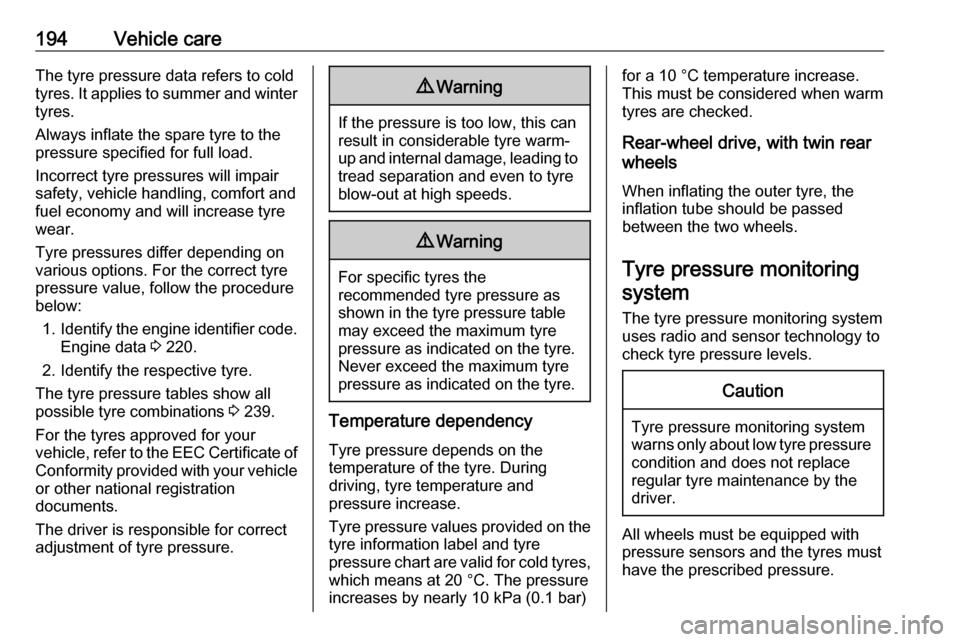
194Vehicle careThe tyre pressure data refers to cold
tyres. It applies to summer and winter tyres.
Always inflate the spare tyre to the
pressure specified for full load.
Incorrect tyre pressures will impair
safety, vehicle handling, comfort and
fuel economy and will increase tyre
wear.
Tyre pressures differ depending on
various options. For the correct tyre
pressure value, follow the procedure
below:
1. Identify the engine identifier code.
Engine data 3 220.
2. Identify the respective tyre.
The tyre pressure tables show all possible tyre combinations 3 239.
For the tyres approved for your
vehicle, refer to the EEC Certificate of
Conformity provided with your vehicle
or other national registration
documents.
The driver is responsible for correct
adjustment of tyre pressure.9 Warning
If the pressure is too low, this can
result in considerable tyre warm-
up and internal damage, leading to tread separation and even to tyre
blow-out at high speeds.
9 Warning
For specific tyres the
recommended tyre pressure as
shown in the tyre pressure table may exceed the maximum tyre
pressure as indicated on the tyre.
Never exceed the maximum tyre
pressure as indicated on the tyre.
Temperature dependency
Tyre pressure depends on the
temperature of the tyre. During
driving, tyre temperature and
pressure increase.
Tyre pressure values provided on the
tyre information label and tyre
pressure chart are valid for cold tyres, which means at 20 °C. The pressure
increases by nearly 10 kPa (0.1 bar)
for a 10 °C temperature increase.
This must be considered when warm
tyres are checked.
Rear-wheel drive, with twin rear
wheels
When inflating the outer tyre, the
inflation tube should be passed
between the two wheels.
Tyre pressure monitoring system
The tyre pressure monitoring system
uses radio and sensor technology to
check tyre pressure levels.Caution
Tyre pressure monitoring system
warns only about low tyre pressure condition and does not replace
regular tyre maintenance by the
driver.
All wheels must be equipped with pressure sensors and the tyres must
have the prescribed pressure.
Page 249 of 255

247Child restraint installationlocations ................................... 63
Child restraints.............................. 60
Child restraint systems ................60
Cigarette lighter ........................... 84
Cleaning the vehicle ...................209
Climate control ............................. 16
Climate control systems .............112
Clock ............................................ 83
Coat hooks ................................... 71
Collision damage repair ..............243
Control indicators.......................... 89
Control of the vehicle .................129
Controls ........................................ 80
Convex shape .............................. 35
Coolant ....................................... 173
Coolant and antifreeze ...............215
Coolant heater ............................ 119
Cornering light ....................107, 182
Coupling ball bar ........................167
Cruise control ...................... 97, 154
Cupholders .................................. 71
D Danger, Warnings and Cautions ...4
Dashboard .................................... 10
Daytime running lights ...............106
Declaration of conformity ............241
DEF ............................................ 138
Demisting and defrosting ..............16Diesel exhaust fluid ....................138
Diesel fuel ................................... 163
Diesel fuel filter .......................... 178
Diesel fuel system bleeding .......178
Diesel particle filter ....................137
Door locks..................................... 22
Door open .................................... 97
Doors ............................................ 27
DPF (diesel particle filter) ...........137
Driver assistance systems ..........154
Driver Information Centre .............98
Driving characteristics and towing tips .............................. 166
Driving economically................... 129
Driving hints ................................ 129
E ECO mode .................................. 129
ecoScoring.................................. 100
Electric adjustment ......................35
Electrical system......................... 187
Electronic climate control system 114
Electronic driving programmes ..147
Electronic Stability Program 95,
152, 167
Electronic Stability Program off ...95
Emergency exit .......................38, 40
End-of-life vehicle recovery .......171
Engine compartment fuse box ...188
Engine coolant ........................... 173Engine coolant temperature ........95
Engine coolant temperature gauge ....................................... 87
Engine data ............................... 220
Engine exhaust .......................... 137
Engine identification ...................218
Engine oil ...........172, 215, 219, 238
Engine oil additives ....................215
Engine oil level monitor ................87
Engine oil pressure ......................96
Engine oil viscosity grades .........215
Enhanced Traction function....... ................................ 151, 152, 154
Event data recorders ..................243
Exhaust gases ............................ 137
Exit lighting ................................ 111
Exterior care .............................. 209
Exterior light ................................. 97
Exterior lighting ....................14, 104
Exterior mirrors ............................. 35
F
Fault ........................................... 148
Fire extinguisher ........................... 77
First aid ......................................... 76
First aid kit ................................... 76
Fixed air vents ........................... 126
Fog light ....................................... 97
Fog lights ............................ 108, 182
Folding mirrors ............................. 36